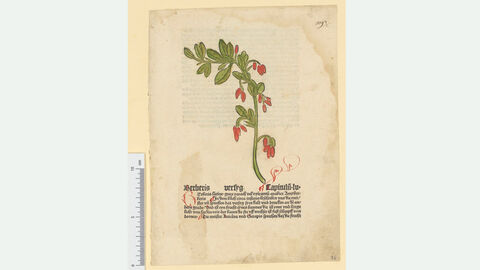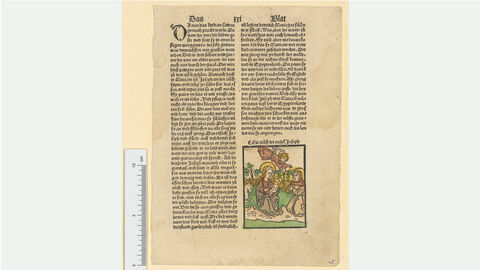The following entry, dated 26 July 1929, may be found in an inventory register of the Hessisches Landesmuseum Darmstadt: “W. L. Schreiber, Der Buchholzschnitt im 15. Jahrhundert in Originalbeispielen. 55 Inkunabelproben mit Textheft [The Book Woodcut in the 15th Century, with Original Examples: 55 Specimens of Incunabula with Brochure] Munich, 1929.” The work was purchased for 1,200 Reichsmarks from the Munich antiquarian bookshop of Weiss & Co. But what happened to this now vanished publication? Was it destroyed by fire, together with the rest of the museum’s library, during the devastating air raid on Darmstadt on the night of 11 to 12 September 1944? Or was it stolen from one of the museum’s evacuation locations? What is so special about this publication is that it is composed of original pages from printed books of the period around 1500—so-called incunabula—each mounted on a sheet of cardboard and furnished with an explanatory label. The edition consists of only 100 numbered copies—50 in German and 50 in English. In order to establish whether there are any incunabula pages of unproven provenance in the Hessisches Landesmuseum Darmstadt’s own collection, that might have originated from this publication, it was first of all necessary to find another complete copy of the work with accompanying booklet. A copy was discovered in the University of Heidelberg library and used to reconstruct the Darmstadt copy. The digitalized version is accessible at the website of the Heidelberg University LibraryOpens in a new window.
For the comparison, the titles of the books from which the individual pages had been extracted in 1929 had first to be determined. Each of the 100 copies contains a different page from the incunabulum in question. It was discovered that 48 of the 55 pages still exist: while being evacuated to a safe location during the Second World War, they had been detached from their cardboard sheets and after 1945 newly inventoried with consecutive numbering. The remaining seven pages could also be found in the museum’s databank. Because the pages’ inventory numbers were subsequently altered, their original relationship was forgotten. The provenance of the 55 pages is thus now resolved. Since the work was acquired in 1929, expropriation as a result of national socialist persecution may be discounted. Yet why, back then, did the antiquarian book dealer Weiss cause dozens of antique books to be cut up and the renowned incunabula expert Wilhelm Ludwig Schreiber to write an accompanying brochure? From today’s perspective, dismembering original texts in this fashion is an absolutely deplorable practice. It is therefore reasonable to assume that the publication made use of damaged and incomplete incunabula. These were obviously unmarketable—but cut up, attractively mounted on sheets of cardboard, and stored in a linen-covered cassette, they could nevertheless be offered for sale. The existence of an English edition indicates that the work was also addressed to researchers and collectors abroad. A simple Internet search, for instance, reveals that two copies exist in stateside research libraries.

